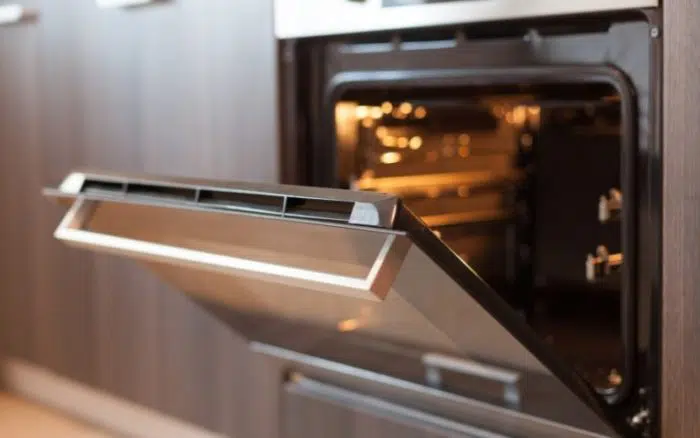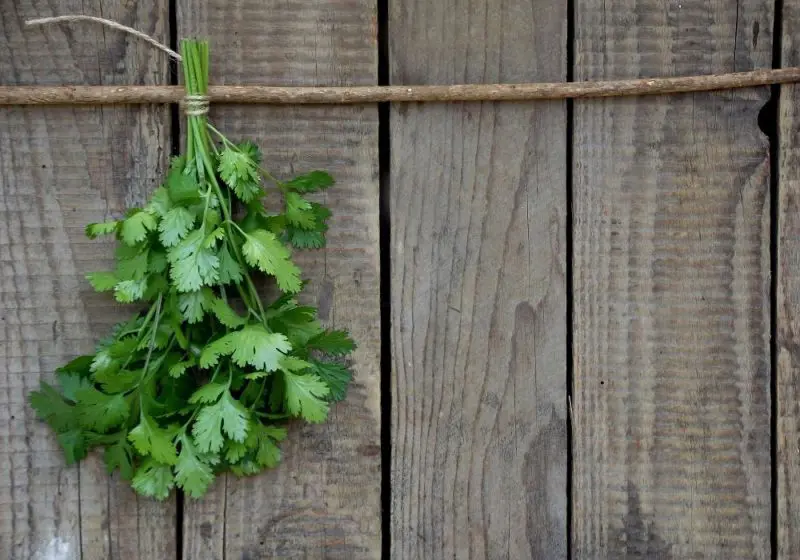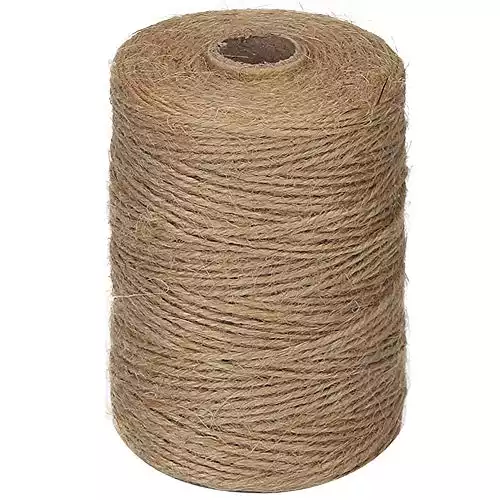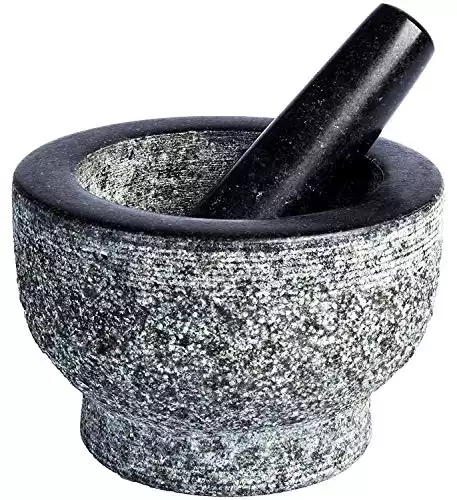Cilantro has become a staple in our household. I’m a huge guacamole fan, so having cilantro nearby at all times is pretty crucial.
But it often just ends up a slimy mess in the fridge.
I’ve started using dried cilantro instead of always trying to keep up with the fresh stuff, and it’s been working quite well!
There are a few ways you can dry fresh cilantro (also known as coriander) and store it in your pantry.
How to Dry Cilantro Leaves
There are 4 main ways you can preserve cilantro, or any herb for that matter. You can dry cilantro in the microwave, the oven, using a dehydrator, or by hanging your cilantro up to dry for a few weeks.
1. Drying Cilantro in the Dehydrator
If you’ve ever used a dehydrator, you know that this method is SO simple.
Dehydrating is quickly becoming my favorite method for turning fresh herbs into a more sustainable pantry item. This is my favorite dehydrator!
Some air fryers even have the option to use them as a dehydrator now, so you might have a tool in your kitchen that is ready to do this. You want to make sure that the dehydrator you’re using allows you to turn the temperature down. For herbs, around 95 degrees F is ideal. Remember, low and slow!
1. Wash Your Cilantro
I like to soak my cilantro for a few minutes to remove any excess dirt or bugs that may have made their way in from the garden.
You can then pat dry, or use a salad spinner to get any excess moisture off. Leave the stems intact as they provide great flavor as well!
2. Place Cilantro On the Dehydrator Trays
Make sure to give the leaves enough space to dry out. You don’t want to overcrowd the racks as it will extend the dehydration process to get to the finished product.
3. Set your food dehydrator to 95 F for 4 hours
While you want to set the dehydrator for 4 hours, it’s a good idea to be checking it after 2 hours.
2 hours will likely not be enough time, but it’s a good time to start checking on your herbs. It can take up to 6 hours for your cilantro to fully dry out depending on the humidity of the room, how much you’re drying, etc. But you also don’t want them to start cooking, which is why you want to check them after 2 hours.
4. Once your leaves are crunchy to the touch, they’re ready!
Once you can break the cilantro leaves in your hand, and don’t find any wet leaves on the trays, you’re ready to put them into an airtight container or jar.
Mason jars and spice jars are great options for storage. See the processing section below for more on this.

2. How to Dry Cilantro in the Oven
If you don’t have a dehydrator, you can use your oven to dry cilantro as well.
1. Preheat the oven to your lowest temperature setting.
For most ovens that will be around 170 degrees Fahrenheit.
2. Cover a baking tray or cookie sheet with parchment paper.
If you just put the leaves on the baking sheet you will be in for a whole mess later on as they will still to the sheet and you’ll lose quite a bit of your leaves (lesson learned!).
You can also spray it with baking spray, but I think that changes the flavor a bit.
3. Layout your washed cilantro on the sheet, being sure to keep them in a single layer.
Any overlap will cause uneven drying and increase the time it takes.
With oven drying, I would recommend removing the stems to give yourself more space and get a more evenly dried herb.
4. Set a timer for 30 minutes.
It won’t be done after 30, but you’ll want to check on it and possibly move some of the leaves around to make sure they are drying evenly.
Try to keep the oven door closed as much as you can as to not let the heat out.
5. Check the leaves every 15 minutes or so after that if they are starting to look done.
If they still seem super wet, you can increase that time frame to about 30 minutes.
Just make sure to keep an eye as you don’t want to start cooking them instead of drying them.
3. How to Dry Cilantro in the Microwave
This method is super convenient, but it also removes the most flavor of the 4 methods. If you’re in a time crunch though, this still works.
1. Place a paper towel on a microwave-safe dish
2. Lay your fresh cilantro on the paper towels
Make sure to have only one layer of leaves, as overcrowding the plate could cause uneven drying.
3. Microwave for 1 minute, and then check your leaves
This is usually never enough time, but depending on how much cilantro you’re drying, it could be! We want to avoid over-drying the leaves, so it’s important to keep a close eye on them.
4. Add 15-30 second increments until your leaves are crunchy and dry
This usually takes around 1 minute 45 seconds to 2 and a half minutes total.
5. Once your leaves are dry, you can remove the stems.
6. Place the cilantro leaves in your jar of choice.
You can crush the leaves up into a small powdery substance, but leaving the leaves whole can improve the flavor and shelf life.
4. How to Air Dry Cilantro

1. Wash your cilantro
Pat dry to remove any excess moisture – you can also use a salad spinner for this. Keep the stems on as this is how you will hang the cilantro.
2. Tie your sprigs of cilantro together (about 10 to a bunch) with twine or jute.
3. Find a location that gets good air flow where you can hang your cilantro for 1-2 weeks.
A basement can be a good spot, or you can hang them against a fence or from a clothesline if you have one.
I would avoid hanging them in the garage as is can get a little too damp in there and there isn’t great airflow. If your garage isn’t damp and has air flow, then this is absolutely somewhere you can dry your cilantro. 🙂
Some people like putting a paper bag over the bundles of cilantro as they dry. This helps catch any leaves that fall off and keeps outside influences (i.e. insects and animals) from getting to your drying herbs.
4. When the leaves are crunchy, they’re ready!
The drying process can take a week or even two weeks depending on the drying location. Keep a close eye, but know that this method of drying a fresh herb does take a while.
Breaking Up Dried Cilantro
Once you’ve dried your cilantro, I like to use a mortar and pestle to grind it up so it fits well in an airtight jar or other airtight container.
You can also use a blender on the pulse setting, or just crush them up with your hands. I would wear gloves if you do this so the oils on your hands don’t contaminate them and lower the shelf life.
Label Your Jars!
We all have great intentions, but labeling with the date and what the spice is will help keep your pantry organized and let you know when it’s almost time to dry some more cilantro 🙂
Is Dried Cilantro as Good as Fresh?
I’ll always prefer fresh cilantro. But dried cilantro is a great option during the off-season when you’re craving that Mexican or Indian flavor.
You’ll want to keep in mind that dried herbs are a little more potent than fresh ones, so you might need to cut the herb part of the recipe in half.
If a recipe calls for 1 tablespoon of cilantro, I’d probably use 1/3 to 1/2 that amount when using dried. Even if you love the cilantro flavor, it can be a bit much when using the dried version.
The Trick to Storing Fresh Cilantro
I don’t know about you, but every time I get cilantro home it seems like I have mere hours before it’s all wilted.
But there’s a trick to storing cilantro! When you get your cilantro home, or harvest it from the garden, get a glass of water and place the stems in it. It’s kind of like storing fresh basil, but somehow this never seems to be talked about.
Use as needed, and change the cilantro water every few days to keep it fresh. This method should help you keep cilantro fresh for about a week.
How to Use Dried Cilantro
Cilantro is such a versatile spice that you can use it in a variety of ways. You can add it to cooked dishes like:
- Arroz Con Pollo
- Any egg breakfast dish like an omelette or quiche
- Salads
- Cooking oils
- Indian dishes like curries and masala’s
- Mexican dishes as well
Preserving herbs can save you money and help keep you from throwing away foods that are on their way to the trash or compost bin. And you won’t have to buy as many dried herbs from the spice aisle!




